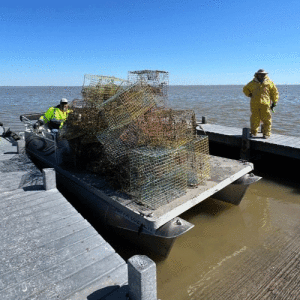
Every February, Texas Parks and Wildlife Department closes the bays to commercial and recreational crabbing for a 10-day period. This temporary closure enables removal of derelict traps which continue to entrap and kill crabs, fish, and turtles.
This year, 900 traps were removed from the three Mid-Coast Bays (Matagorda, San Antonio, and Aransas). Additionally, 543 loose Styrofoam floats were removed too. Crabbers use the floats to mark the traps, but they can get cut off due to storms or boat props.
“It’s very important to remove these old traps because they not only kill crabs and fish, they’re also navigation hazards and unsightly litter.” said Allan Berger. Berger, Chair of San Antonio Bay Partnership has been organizing efforts in the Mid-Coast bays for the past 8 years. “Removal of derelict traps involved 64 boats and 204 participants over the ten-day closure.”
Other organizations leading the search efforts in their respective bays were Mission-Aransas National Estuarine Research Reserve, Lavaca Bay Foundation, and Matagorda Bay Foundation. Volunteers and organizations included USFWS Aransas National Wildlife Refuge, TPWD Coastal Fisheries and Game Wardens, local chapters of the Coastal Conservation Association, Guadalupe Blanco River Authority, Guadalupe Blanco River Trust, San Antonio River Authority, International Crane Foundation, Mid-Coast Texas Master Naturalists, Dallas Zoo, Lavaca-Navidad River Authority, and Texas Conservation Alliance.
This is the fourth year that a cellphone-based app was used to collect data on each removed trap. “The data reveals that most of the derelict traps are on the shoreline, likely the result of weather events. However, a significant number appear to be in place and not picked up by crabbers. It is anticipated that an analysis of the data can reveal root-causes and result in fewer lost traps in the future” according to Berger.
“Participation was up from last year.” continued Berger. “While technology helps, it’s still about boats and volunteer’s eyes on the water. We utilized more airboats this year, improving our ability to see traps in the vegetation, many of which may have been lost in previous years. Last year we removed 977 traps. We did a more comprehensive search this year, so the decline in traps is welcome news.”
The derelict crab clean-up effort was supported with funds obtained by TPWD from the Gulf States Marine Fisheries Commission, and from a grant obtained by SABP from Restore America’s Estuaries. Local funding was also provided by the GBRA and the SARA. If you want to be included in the early planning for next year, contact Allan Berger at AllanRBerger@outlook.com. -Brigid Berger
